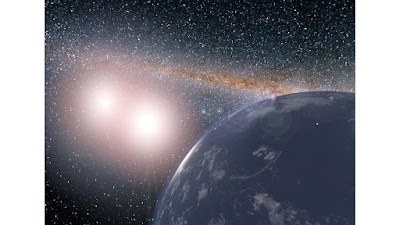An artist's impression of the cosmic web (Volker Springel/Max Planck Institute for Astrophysics/et al)
Topics: Astronomy, Astrophysics, Cosmology, Dark Matter, Einstein, Research
Q: Why does science seem to always change its mind?
A: Because, the enterprise of science is about discovery, and a lot of discoveries happen when you have better instrumentation, apply The Scientific Method and rigorous peer review. (See the quote below by economist John Maynard Keynes)
When science tried to fit the universe into a mechanistic viewpoint, it coined something called the luminiferous aether. Albert Michelson and Edward Morley built what we now know as an interferometer to measure its existence, and ended up measuring the speed of light. It earned them the Nobel Prize. Theirs were the shoulders on which Einstein built his Theory of Relativity, along with Newton, Faraday and others. Knowing better, science changes its mind.
“When the facts change, I change my mind - what do you do, sir?”
― John Maynard Keynes
There might not be a mysterious 'dark' force accelerating the expansion of the Universe after all. The truth could be much stranger – bubbles of space where time passes at drastically different rates.
The passage of time isn't as constant as our experience with it suggests. Areas of higher gravity experience a slower pace of time compared with areas where gravity is weaker, a fact that could have some pretty major implications on how we compare rates of cosmic expansion according to a recently developed model called timescape cosmology.
Discrepancies in how fast time passes in different regions of the Universe could add up to billions of years, giving some places more time to expand than others. When we look at distant objects through these time-warping bubbles, it could create the illusion that the expansion of the Universe is accelerating.
Two new studies have analyzed more than 1,500 supernovae to investigate how likely the concept could be – and found that the timescape model might be a better fit for observations than our current best model.
The standard model of cosmology does a pretty good job of explaining the Universe – provided we fudge the numbers a bit. There doesn't seem to be enough mass to account for the gravitational effects we observe, so we invented an invisible placeholder called dark matter.
There also seems to be a strange force that counteracts gravity, pushing the cosmos to expand at accelerating rates. We don't know what it is yet, so in the same spirit we dubbed it dark energy. All of this comes together, along with ordinary matter, to form what we call the lambda cold dark matter (ΛCDM) model.
The problem is that this model uses a simplified equation that assumes the whole Universe is smooth, and expands at the same speed everywhere. But it's far from smooth out there: we see a colossal cosmic web, crisscrossed by filaments of galaxies separated by vast voids emptier than we can comprehend.
Timescape cosmology takes that 'lumpiness' into account. More matter means stronger gravity, which means slower time – in fact, an atomic clock located in a galaxy could tick up to a third slower than the same clock in the middle of a void.
When you stretch that over the huge lifespan of the Universe, billions more years may have passed in the voids than in the matter-dense areas. A mind-boggling implication of that is that it no longer makes sense to say that the Universe has a single unified age of 13.8 billion years. Instead, different regions would have different ages.
And since so much more time has passed in the voids, more cosmological expansion has taken place there. Therefore, if you look at an object on the far side of a void, it would appear to be moving away from you much faster than something on this side of the void. Over time, these voids take up a larger proportion of the Universe, creating the illusion of an accelerating expansion, without needing to conjure up any dark energy.
Dark Energy May Not Exist: Something Stranger Might Explain The Universe, Hinah Shah, Shining Science
